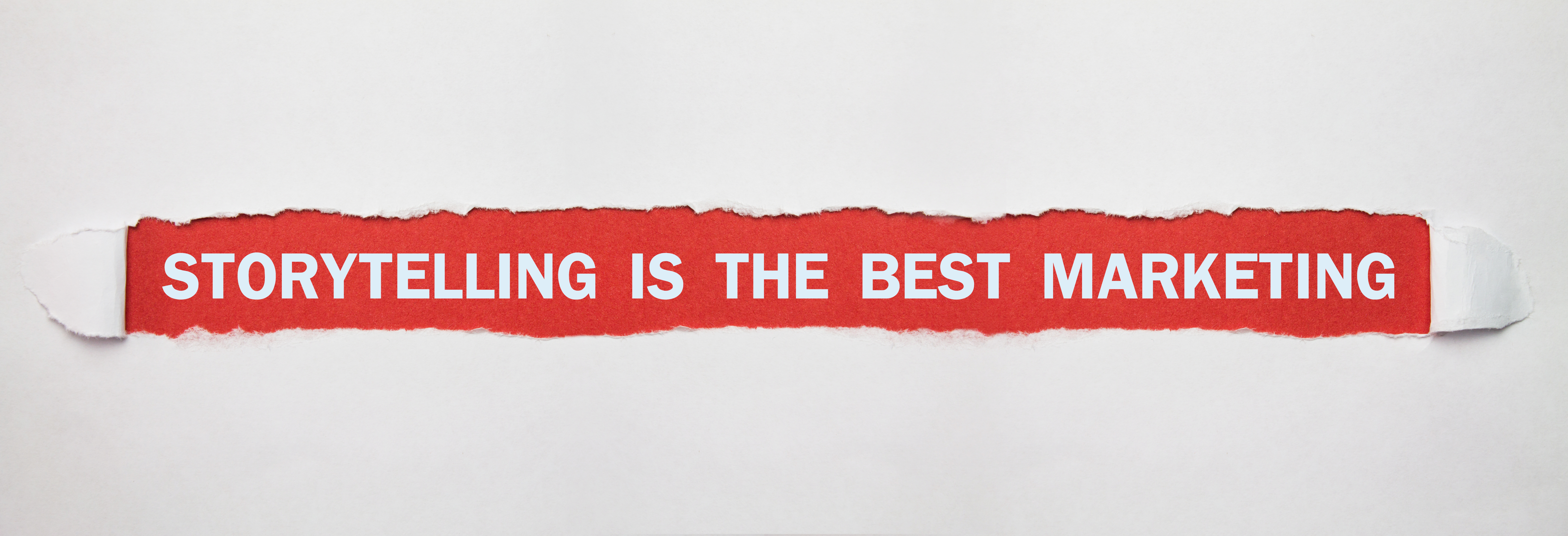I had a loyal audience by the time I was five.
As a child I constantly made the people in my life watch me perform puppet shows. If you’ve ever listened to a child tell a story you know how big of an ask that can be. But, I always had an audience! Even when they were tired or busy, they remained entertained as I trailed on in different voices.
In the years since, I’ve realized why my puppet shows were so well received. they always had a plot, and the show wasn’t over until I bowed-my way off the “stage” with a positive message.
I wasn’t just giving a puppet show. I was telling a story. You can use storytelling to win over your customers, too!
Today I’m going to tell you how YOU can use stories to build the relationships in your life and for your business.

Relatable Stories are Customer-Engagement Gold
You already know how powerful personal relationships are in this industry. They can make or break loyalty, which means they can help or hurt your business as a whole. This is why we talk about engaging your customers as much as we do; it’s a necessity, especially for guest-based businesses.
So, you need easy and familiar ways to connect with customers while showcasing your personality.
Stories are cultural ties to human connection, making them an excellent tool for engaging your customers. Stories increase the value of your marketing by building a closer tie with the “humans” you want relationships with.
Fortunately, you don’t have to be a professional writer or aspiring novelist in order to leave a lasting impression on customers.
“I’m not a storyteller!”
But you are! We all tell stories every day. We use stories to make people laugh, from personal connections, to explaining who we are to the world. Telling YOUR stories is actually second nature, and it’s a skill anyone can bring into the club marketing world.
Through storytelling you have the opportunity to tell your patrons (and future patrons) anything you want to, with as much passion and excitement as you actually feel.
In this article, I’m going to explain a few different types of stories you can easily use to build your business. But first, let me give you the best tip I have for storytelling:
Think of drawing your customers’ attention as though they are part of YOUR FAMILY and you want to get to know them better.
Imagine that you’re having a conversation, even when you’re writing out a newsletter or a blurb for your website. The more personal your story sounds, the more of a connection it will build.
So What’s A Story, Exactly?
A story is essentially an outline of an event that is either made-up or real and gives a descriptive account of someone’s EXPERIENCE. We were raised with stories and use them to relate to people all the time:
- Watching entertainment like Star Wars
- Reading an autobiography about your favorite Pro
- Hearing folktales such as “Rumpelstiltskin” passed down from generations before
There are a few basic types of stories, and it’s good to know the difference when you’re trying to engage your customers.
1. Anecdote: Entertainment with Words
An anecdote is simply a short story that gives description and appeals to emotion. If you got this far in the article, my opening anecdote technique worked!
Anecdotes are spoken in first-person narrative such as: “I knew Jeff was a passionate golfer the moment I met him my senior year. I first saw him in the hallway carrying a golf club.”
2. Analogy: The Story Version of a Simile
Analogies are all about comparing two different things that have similarities. Such as: “Her eyes were as bright as the morning.”
Try using this formula as a method to create an analogy to motivate club software service updates: “_____is just like____but is different because it is____for you.” This is a familiar way to speak customers’ language.
3. Hypothetically Speaking: A “For Instance” Story
Last, is using a hypothetical. This strategy allows you to place a customer in a positive situation where you imagine the best possible outcome to that story.
This also helps people think of more possibilities, plus imagine themselves acting out the scenario as they read.
Here is a hypothetical exercise for a way golf clubs could use a hypothetical in their email to encourage lesson signups:
“When you sign up for _____ lessons and commit to practicing _____ days a week, you’ll find that you’ll be able to _______ and ____, better, faster, and for as long as you desire.”
Hypotheticals function as stories too! Not only do they persuade you to place yourself as the reader inside the story, they can turn on the creative button which influences the productive parts of the brain to DO more! Such as:
“Get out to visit the golf course and be part of our second-family club community!”
All of the tips above are examples of storytelling, so don’t be afraid to start telling them!

Getting Started with Storytelling
Business owners can share personal stories that will leave a long-lasting impression. Search for fun situations to tell customers about and tell them with personality.
Like any good and relatable story, customers won’t be able to resist spending more time— and therefore money—at your club.
I’m going to give you a few examples to get started, but first here are a few tips.
Storytelling Tips
- Remember to KEEP IT REAL.
When it comes to relating to more customers, focus on real stories (or actually possible hypothetical stories) that your audience can relate to, rather than fictional. - Know your goal.
Are you trying to get the word out about your business, or generate registrations for a tournament? Are you encouraging people to come eat at your restaurant, or are you hoping to get more people signed up for lessons? Or are you simply using a story as a touch-point to keep you and your business front and center of your customers’ minds?
Whatever your goal, pick a story that supports it.
- Share your excitement.
Your club is your home, so you are the keeper of all the exciting stories. The more exciting your story narrative sounds, the more excited they will feel.
I like to relate this to watching a movie. When you are focused on a movie, you forget the world around you. When the character on screen feels an emotion, you feel the emotion too. The hero is in a frightening scenario, you start to feel anxious. Your heart races.
While it’s not quite as easy without a soundtrack and some special effects, a story that is built from excitement can have a similar effect. What can you help them feel to convince them to visit? What story can you tell that will help elicit that emotion?
Some Quick Story Ideas
- A customer interaction that became a meaningful relationship
- Memories on the green “Dance Floor”
- Profiles about people behind the scenes, such as a fitness coach or head chef
- The best embarrassing story about your Pro
- The reason you start offering a specific food item
- A successful lesson learned from a recent experience
- My opening story about my family is also an example
A Real Example
Read below for how the The Field Golf Club of Greenwich, Connecticut & their communications team decided to tell real stories as part of their newsletter. Featured below is part of Chef’s Story:
“Remembering Jack Stauffer is easy; he was genuine, witty, caring and funny. Jack had a great quality of making you feel that you were the most important person in the room. One evening while Mrs. Stauffer was dining at the club with guests, she mentioned that they had written a cookbook and if I would like a copy… I added it to my collection immediately…
Shortly after receiving a copy of the cookbook, Chef was inspired by the contents and extended an invitation to Mrs. Stauffer to join him to prepare her signature “Chicken Cordon Bleu” dish together. The featured dish became a ‘seasonal special’ on the weekly menu and Mrs. Stauffer became a household name.”
Where to Share Stories
So now that you have some ideas in mind, where are you going to TELL these stories? How can you get your voice in front of your customers, (and your not-yet-customers)?
- Use a story to begin your next newsletter
- Send stories to your email list
- Write stories as blogs that are posted on your business website
- You can even use stories for club event invitations
Now is the time!
The season has just started for most states, which makes now a perfect time to start engaging last year’s guests. 
- Are there any funny stories from last year?
- Have you added something new to your facility or your course? If so, why? What’s the story behind that?
- Did you hire any new staff members? Who are they? Why did you hire them?
Customers want to hear your stories, so pick a goal, pick a story, and start telling!
![story_AdobeStock_212202304-[Converted]](https://cdn2.hubspot.net/hubfs/3377150/story_AdobeStock_212202304-%5BConverted%5D.png)

